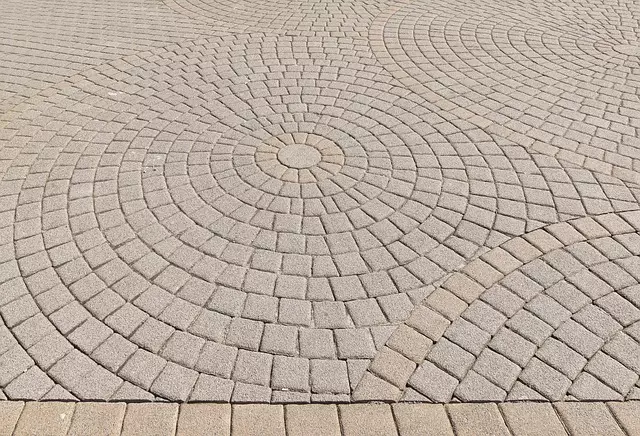In Toledo, Ohio, the advanced concrete slab pouring process is critical for effective water runoff management, ensuring both structural integrity and environmental sustainability. Contractors must tailor their approach to local hydrological conditions and soil types. The latest preparation techniques are employed to integrate sophisticated drainage solutions within the concrete slab systems, which are designed to be durable, stable, and capable of withstanding heavy traffic and environmental stressors. These systems offer numerous benefits, including longevity, low maintenance, and resilience against Toledo’s varied climate. The process begins with meticulous site preparation, including clearing, leveling, and installing drainage systems to prevent water accumulation. Quality concrete mixing, precise placement using a screed, edge work for expansion joints, and careful curing are all integral steps to achieve a high-quality slab. Regular maintenance post-installation is essential for maintaining the integrity of these systems, with Toledo’s unique conditions necessitating climate-specific admixtures and ongoing inspections to ensure long-term effectiveness. Investing in a concrete slab pouring process that follows rigorous preparation steps is a prudent choice for both residential and commercial construction in Toledo, ensuring a foundation that is both functional and adaptable to future challenges.
When addressing the critical nature of effective drainage in modern structures, particularly in regions like Toledo with varying climate conditions, understanding the intricacies of concrete slab pouring processes and subsequent maintenance is paramount. This article delves into innovative solutions for managing water runoff, ensuring the longevity of concrete slabs through expert preparation steps, and highlighting the myriad benefits these structures offer in terms of durability and efficiency. Join us as we explore the essentials of maintaining concrete slab drainage integrity to safeguard your property against moisture-related issues.
- Optimizing Water Runoff Management with Advanced Concrete Slab Drainage Systems
- The Essentials of Concrete Slab Pouring Process in Toledo: A Step-by-Step Guide
- Unlocking the Durability and Efficiency Advantages of Concrete Slabs
- Effective Maintenance Strategies for Concrete Slab Drainage Integrity
Optimizing Water Runoff Management with Advanced Concrete Slab Drainage Systems

In the realm of civil engineering and construction, managing water runoff efficiently is paramount to maintaining structural integrity and ensuring environmental sustainability. Advanced concrete slab drainage systems have emerged as a pivotal solution in optimizing this critical aspect. These systems are designed with cutting-edge technologies that facilitate proper water flow and mitigate the risks associated with water accumulation. The concrete slab pouring process in Toledo, as with many regions, must account for local hydrological conditions and soil types to ensure effective drainage. Contractors adhering to the latest concrete slab preparation steps incorporate these considerations into their work, ensuring that each slab is laid with optimal water runoff management in mind.
The benefits of concrete slabs are manifold, particularly when they are part of a sophisticated drainage system. They provide a durable and stable foundation that can withstand the pressures of heavy traffic and environmental stressors. By integrating advanced drainage solutions within the concrete slab pouring process, Toledo-based projects can anticipate and manage water runoff effectively. This integration not only protects the structural elements beneath but also promotes better water resource management, reducing the potential for flooding and erosion. The use of high-performance materials and design strategies in concrete slab preparation steps ensures that these systems are not only functional but also adaptable to future changes in precipitation patterns or urban development. As a result, properties with such systems are better equipped to handle the challenges posed by changing weather patterns and urban growth, making them a wise investment for both residential and commercial applications.
The Essentials of Concrete Slab Pouring Process in Toledo: A Step-by-Step Guide

When undertaking a concrete slab pouring project in Toledo, understanding the essential steps of preparation and execution is crucial for achieving a durable and high-quality result. The process begins with thorough site preparation, which involves clearing the area of debris, leveling the ground, and ensuring proper drainage to prevent water accumulation post-pour. This initial step is vital as it forms the foundation upon which the slab’s integrity relies.
Once the site is prepared, the next phase is mixing the concrete. The mix should be properly proportioned to fill the intended area without excess that could lead to weaknesses or waste. A fresh batch of concrete should be used for each section of the slab to maintain consistency and quality throughout the pour. Following the mixing, the concrete must be transported to the site and placed with precision. Technicians must use a screed to level the concrete, ensuring it is even and properly graded for water runoff. Edge work is then performed to finish the edges of the slab, allowing for proper expansion joint placement.
During the curing process, which immediately follows the pour, maintaining moisture and temperature control is essential to ensure the concrete reaches its designed strength. The benefits of concrete slabs in Toledo are manifold; they offer a durable, low-maintenance surface that can withstand the region’s variable climate conditions. These slabs provide a solid foundation for structures like garages, patios, and driveways, ensuring longevity and safety for years to come. Proper drainage solutions integrated into the concrete slab pouring process are particularly important in Toledo due to its snowy winters and rainy springs, which can saturate the soil and potentially lead to structural issues if not adequately addressed during construction.
Unlocking the Durability and Efficiency Advantages of Concrete Slabs

When constructing a concrete slab, the pouring process in Toledo and its surrounding regions demands meticulous preparation to ensure both the durability and efficiency of the final structure. Proper concrete slab preparation steps are critical; they lay the foundation for a long-lasting surface that can withstand environmental stressors and resist degradation over time. The process begins with excavating the site to precise dimensions, ensuring a level base free of debris and vegetation. This base is then compacted to create a stable platform for the slab. The choice of aggregate, water-to-cement ratio, and the inclusion of admixtures tailored to Toledo’s climate are all factors that contribute to the concrete’s longevity and performance.
The benefits of concrete slabs are manifold, particularly when it comes to drainage solutions. A well-designed concrete slab incorporates a robust drainage system that channels water away from the structure, preventing pooling and reducing the risk of water damage. This system often includes strategically placed drains and a properly graded slope to facilitate water flow. The durability of concrete means that these drainage solutions require minimal maintenance over their lifespan, offering cost-effectiveness and reliability. Moreover, the thermal mass properties of concrete help in moderating temperature fluctuations beneath structures, which can further enhance the efficiency of the space above. By adhering to best practices in concrete slab pouring process in Toledo, homeowners and contractors can reap these advantages, ensuring that the concrete slabs they install are not only resilient but also serve as efficient components within their overall building design.
Effective Maintenance Strategies for Concrete Slab Drainage Integrity

To maintain the integrity of concrete slab drainage systems, a proactive approach is paramount. Regular inspections should be conducted to identify any signs of wear or damage, such as cracks or settlement, which can compromise drainage efficiency and lead to water infiltration. Effective maintenance strategies begin with meticulous preparation during the concrete slab pouring process in Toledo, where the climate and soil conditions must be carefully considered. This involves ensuring proper site grading, implementing effective waterproofing measures, and selecting the right mix design for the concrete to withstand local environmental factors.
After the concrete slab has been poured and cured, ongoing maintenance is crucial. This includes cleaning gutters and downspouts to prevent blockages that could direct water toward vulnerable points in the slab. Sealing joints and cracks as they appear can prevent moisture intrusion, and regular monitoring of drainage paths for any disruptions or obstructions is essential. Additionally, it’s important to keep the surrounding area clear of debris and vegetation that could impede water flow. By adhering to these concrete slab preparation steps and maintaining a rigorous schedule of inspections and repairs, the benefits of concrete slabs—such as their durability, longevity, and low maintenance—can be fully realized, ensuring a drainage system that remains effective for years to come.


